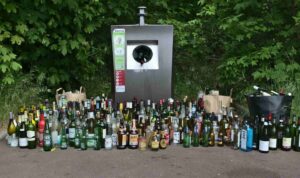Glass bottles are a common container material in daily life, but do you know their environmental value? Because of the stable chemical properties of glass, it is not easy to degrade. If we simply bury the glass underground will occupy a lot of land resources. And will also cause a long-term impact on the environment. Because of this, the recycling of glass bottles is particularly important. This article will help you to understand the reasons and methods of glass bottle recycling and help you better understand how to contribute to environmental protection.

Figure 1 An overflowing glass recycling bin surrounded by a large assortment of empty bottles and jars
Why Glass Recycling?
The main components of glass are silica, calcium silicate, sodium silicate, etc. It is extremely stable chemically and is not easy to incinerate and degrade. It takes around 4,000 years for complete degradation. So it cannot naturally decompose in the soil like ordinary garbage. In the past, half of the glass that people dealt with was landfilled. However, we know that landfilling glass does not change the existence of waste glass, it will still bring many disturbing factors to the natural environment, such as soil and human activities. The best way to deal with waste glass is recycling.
Glass is 100% recyclable. However, some scrap yards cannot recycle glass, why is that? The main reason is that waste glass bottles are heavy and costly to recycle and transport, but the profit is very low. Therefore people often throw away waste glass bottles as ordinary garbage. In this way, glass bottles as a renewable resource are a lot of waste, and more will have an impact on the environment.
So where is the right place for glass to go? Let’s find out in detail.
How to Recycle Glass Bottles and Jars?
Recycled discarded glass bottles and glass jars can be used as casting flux, transformation utilization, remelting, raw material recycling, reuse, etc., to turn waste into treasure.
1. Collect discarded glass containers
In fact, in daily life, as long as we pay more attention, we can find that there are some glass recycling bins or community drop-off points around. We can throw the discarded glass containers at the designated recycling point. Before throwing it away, it is best to rinse the glass bottles with water. Then, the glass is transported to a special glass recycling center.

Figure 2 A close-up abstract view of glass bottles, with soft hues of blue and green blending together, creating a serene and fluid visual effect
2. Preliminary treatment and classification
After the glass arrives at the recycling center, it is transported to the conveyor belt by a forklift. When the glass fragments are transported on the conveyor belt, they will go through a series of processes such as cleaning and filtration, magnetic screening, and vibration dehydration to remove dirt and odor. At the same time, it is also necessary to remove metals, stones, soil, ceramics, and other debris mixed in the waste glass, because glass container manufacturers need to use raw materials with higher purity. For example, if there are metal substances in the broken glass, it will form oxides that interfere with the operation of the furnace; while ceramics and other foreign substances will form magazines when casting glass bottles or glass bottles later. In addition, glass also needs to be classified by color, such as clear glass, brown glass, blue glass, and green glass. Because only clear glass raw materials can be used to produce clear glass. When producing amber glass, only 10% of green or flint glass is allowed to be added.
We must know that glass is 100% recyclable and can be recycled indefinitely. Recycling waste glass can not only greatly reduce the amount of glass waste, but also save energy and protect the environment. So I hope everyone can collect glass bottles in the future and let them be recycled and reused!

Figure 3 Disposal colored glass bottles
Q1: Why can’t mirrors be recycled?
The principle of the mirror is that a silver layer is applied to one side of the glass to create a mirror effect. If you want to recycle it, you need to remove this coating. However, the cost of removal is too high, so it is classified as other garbage and cannot be recycled.
Q2: Why are lamps considered hazardous waste?
Lamps include fluorescent tubes, energy-saving lamps, energy-saving bulbs, incandescent lamps, fluorescent lamps, energy-saving lamps, and mercury-containing fluorescent tubes. For example, fluorescent lamps are a type of fluorescent lamp that contains a small amount of mercury gas, which is a toxic gas. Once a used fluorescent tube is broken, it will release mercury vapor, which will cause harm to human health. Therefore, used fluorescent tubes are considered hazardous waste. Energy-saving lamps contain harmful elements such as lead, phthalates, chromium, and polybrominated biphenyls.

Figure 4 Disposal glass bulbs










